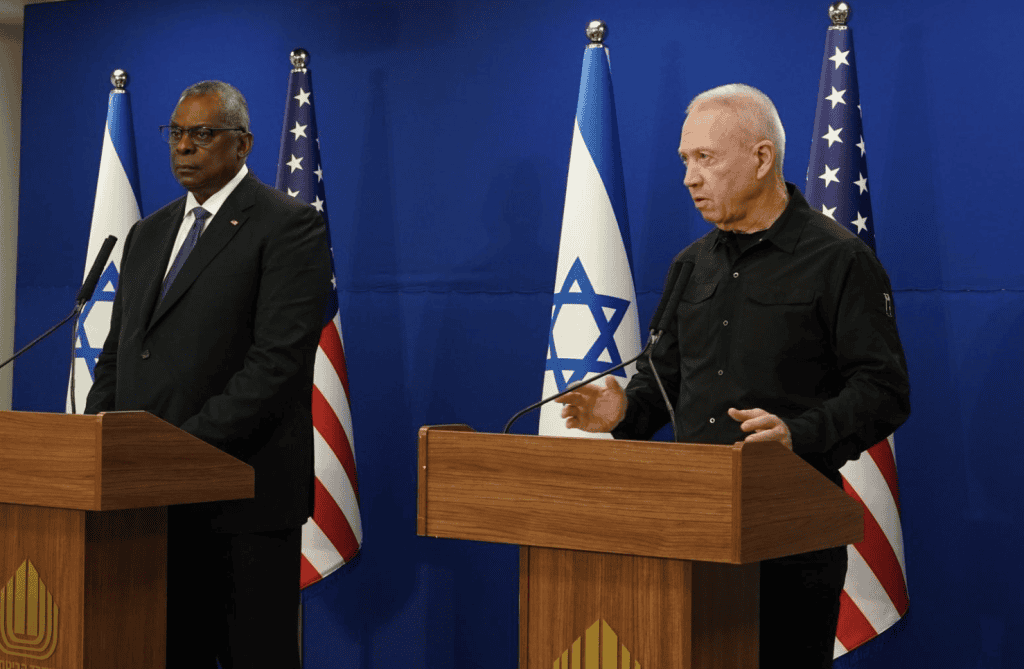
After an Israeli reservist soldier was killed on December 16 by a Hezbollah drone along the northern border, Iran-backed Hezbollah launched several more attacks on Israel on December 18 as US Secretary of Defense Lloyd Austin arrived in the country. Secretary Austin is on a trip to the region that also included a stop in Kuwait on Sunday and stops in Bahrain and Qatar following his meetings in Israel. He was accompanied by the head of the Joint Chiefs of Staff, General Charles Brown. Austin’s trip followed a visit made last week by the head of US Central Command, General Michael Kurilla. Together, these visits — the desire to meet face-to-face to discuss challenges — illustrate the strength of the partnership between the US and Israel.
The visits also happen as Houthi attacks on ships in the Red Sea increased in the last week, and several prominent shipping companies have now paused shipping operations in the Red Sea. The destroyer USS Laboon became the latest US warship to enter the Red Sea amid the heightened threat. The USS Mason and USS Carney are already in the Red Sea confronting the drone and missile threats that have been posed to shipping.
In the meeting with Austin, Israel Minister of Defense Yoav Gallant emphasized that Israel was “operating to minimize harm to the civilian population. We are also working with international partners, to facilitate the delivery of humanitarian aid.” However, he also noted that “anytime we discuss humanitarian issues, we must remember: the 129 hostages still held in Gaza. This is the most humanitarian issue.”
Gallant discussed how Israel was operating in Khan Yunis, targeting Hamas leadership. He also raised the continued threats from Hezbollah. “We will bring back the residents of the north to their homes on the border, after full security will be restored. We prefer to do so via understandings, ensuring that the border region is clear of terrorists, and does not allow direct threats on our citizens. If such a process will not be implemented diplomatically, we will not hesitate to act,” he said. He also said the Houthi attacks are threatening international freedom of navigation.
Messaging from Israel’s leadership on the Houthis and Hezbollah has increased in the last week. The IDF also pointed out on December 18 that Hezbollah has carried out hundreds of attacks since Hamas attacked Israel on October 7. “To date, five Israeli civilians have been killed in these attacks and 80,000 civilians in northern Israel have evacuated their homes,” the IDF said. The statement also noted that Hezbollah is violating UN Security Council Resolution 1701. Israel also accused Hezbollah of carrying out attacks from areas near UN positions in Lebanon: “This demonstrates Hezbollah’s blatant abuse of the international and national institutions responsible for security in southern Lebanon,” the IDF added.
In Gaza, the IDF said it struck 150 targets between December 17 and 18. It used drones to coordinate with ground forces and target terrorists in Khan Yunis and continued to concentrate on fighting Hamas in the Jabalya and Shujaiya neighborhoods of Gaza. In Jabalya, the IDF found more than $1 million in cash in a residence used by Hamas: “The funds were found in suitcases alongside numerous weapons.” A terrorist who participated in the October 7 attack was detained last Friday at a school in the Rimal area of Gaza City, underscoring how neighborhoods mostly secured by fighting in November continue to be areas of interest for IDF operations.
More tunnels were found and destroyed in Gaza. A miles-long tunnel with an opening near the Erez crossing found several weeks ago has been secured and illustrates the complexity of the tunnel system in Gaza. After the IDF announced this discovery, the pro-Iran Al-Mayadeen media highlighted this tunnel and said it was used in offensive operations.
As of the evening of December 18, a total of 461 IDF soldiers had fallen in the war.







